

February 2007
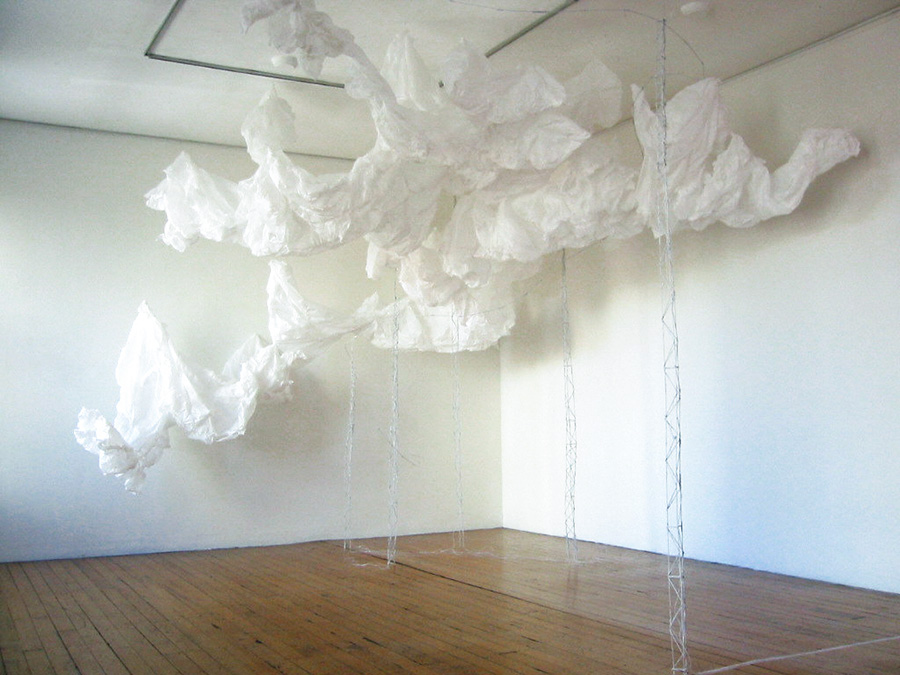
Work from Joanna Langford, the 2006 Olivia Spencer-Bower Fellow, opens the exhibition year at Jonathan Smart Gallery. The show is called "the quietening".
As installation in the front gallery, the billowing cloud-like qualities of tufted, recycled supermarket bags are combined with a scaffolding of painted skewers, to create an atmosphere of weightlessness and fantasy. There is movement and a sense of mesmerising lightness. But there is also a quiet air of menace.
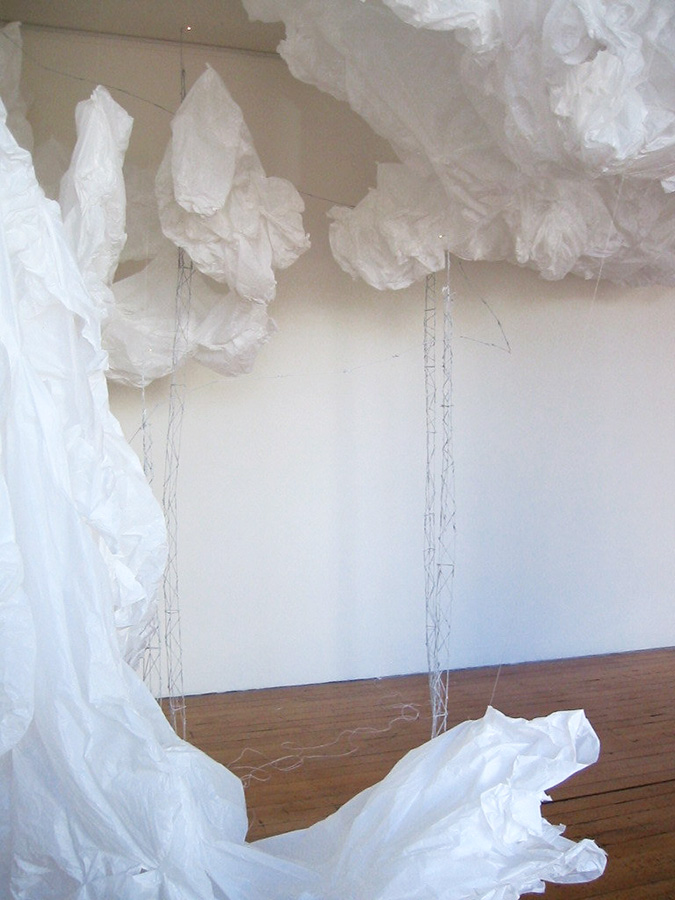 |
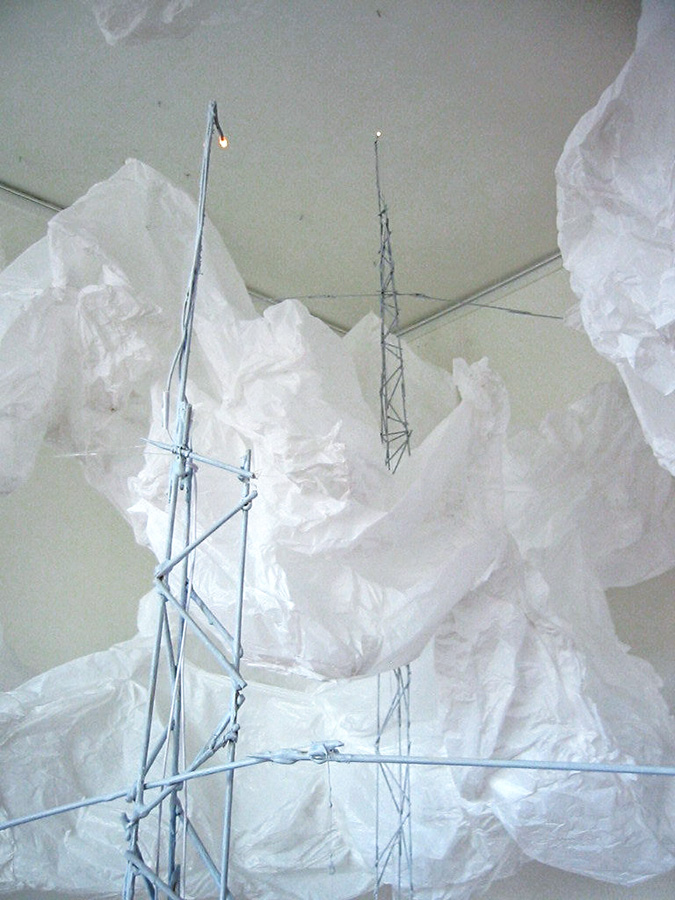 |
My work is not the kind of premeditated making where you research concepts and theories and plan and draw up and make markets. It is very spontaneous and the sort of research I do is very superficial and just happens randomly. For example I will look at a picture for ages and get lost in it and just absorb stuff, kinesthetic experience, and visual experience.
I like the kind of research that just happens to you in the everyday, like you're drinking a cup of tea and the imagery on the cup takes you somewhere, it opens that little door in your imagination and suddenly you find yourself in a spindly little world with bridges and winding paths and old willow trees, I like this kind of experience that catches you off guard in the middle of an everyday ritual . You're not preempted or mentally prepared like when you walk into a gallery. And at the end, you don't know what you have learnt but it was something.
Or research happens to me when I walk into somewhere like the conservatory in the botanical gardens. Its suddenly magic it's like this capsule that is completely different from the outside world. You step from the bitter cold of Christchurch into the humid jungles with banana trees and waterfalls it's a zone that is so physically different to where you are that it feels like anything could happen your imagination is heightened.
Memories of things I have seen and place I have been and travel are a sort of source material, places like Cappadoccia in Turkey other places in South America, mythical and mystical places. Weird landscapes or architecture. Also certain kinds of lifestyles: nomads like the circuses and other wanderers like gypsies that kind of 'make-do' life style where you adapt and create from what you have. Adapting environments and adapting to environments. Roaming, Carnivals, Nomadic, Tramps and Bag ladies. Like camping, like caravans, like sleeping under bridges and in railway cars. You convert things you make a spoon out of a stick or use a ticket booth, or a railway car or a bridge as your accommodation. Resourceful.
Also odd little trinkets and objects that I have lying around, and all those other things like movies and stories and little things that people say I find leak into my work.
Childhood:
I think the childhood associations are sometimes an outcome of the work but not necessarily a starting point for me. My starting point is much more grounded in aspects such as construction and materials, site, processes, collecting and old existing work or ideas from past work. (My practice is very cyclic and often content and imagery and techniques from old work will reappear. For example trees have appeared in my work time and time again often in different forms, characters such as the long legged zebras, clocks as mechanisms to make things move.)
Site:
I have a varied approach to site; sometimes I will make objects that can easily move from site to site. Other work I partially construct in my studio then dismantle and take all the parts into the designated area. I reconstruct the work in the gallery intuitively taking into account aspects of the site. This kind of construction allows the work to change and mutate to the particulars of a site and allowing me to alter the work and control the scale, which alters the way the viewer, will interact with the work. It is a type of 'squatting' the work takes up residency for an allocated time.
Scale:
A twisting of scale that pull and pushes the viewers encounter with the work. Creates tension between the real and the fantastic.
Biscuits and lollies and stuff:
Why do I use them?
To me these are the most interesting and easy to find 'ready mades' they have beautiful textures and colors and smells and their form evolves over time.
Photographs:
I am not using them in the traditional way but kind of subverting them .as Miranda commented I don't use a photograph of a bird as a bird instead I cut up a photo of a biscuit and use this to construct a bird it's a very kind of back to front way of making things.
I think I use the photos as a material which I cut up and use in much the same wayas I would use most materials however there is just that extra layer of history its been recycled then recycled again a bit like lots of the other aspects in my work reused, reinvented. I like that about the photos that they can be reproduced and repeated over and over to form a huge landscape essentially out of one repeated image.
Again it's mostly the formal qualities of the images in the photos that I'm interested in the way that the underside of the (photographed) arrowroot biscuits looks like a strange sort of volcanic landscape.
Construction:
The way it is constructed which is very real and raw and everyday and exposed process and the surreal content is an interesting conundrum. Like an animator will create another world a surreal world but there is no connection between the real world through the evidence of a process or the building of it. However my work does have this, which is a thread that seems to pulls, and push the viewer between the real and enchantment.The construction technique pushes the work as much as the material. How materials react to each other where the type of construction and the qualities of the material will go how far they can be pushed.
Conceptual and the romantic
Contemporaneity and antiquity
Everyday and enchantment.
Drawings - back gallery
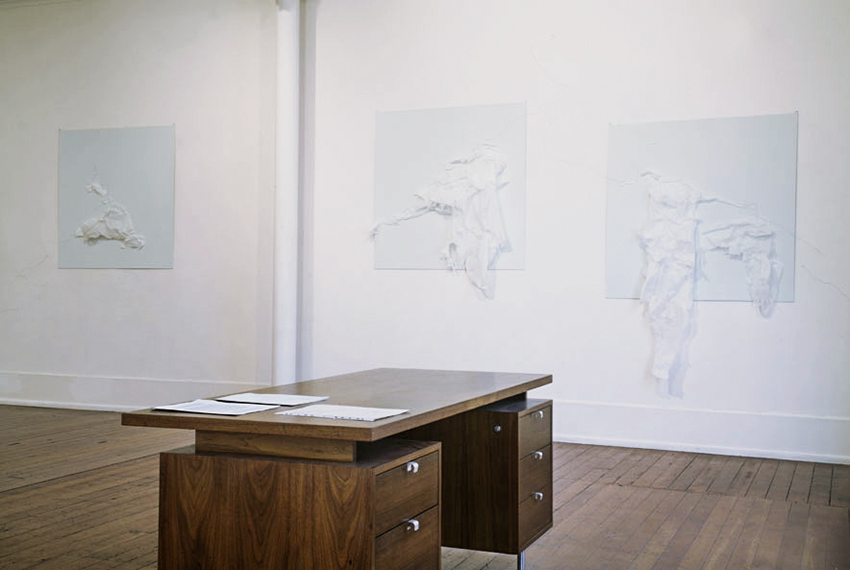
Installation view back gallery
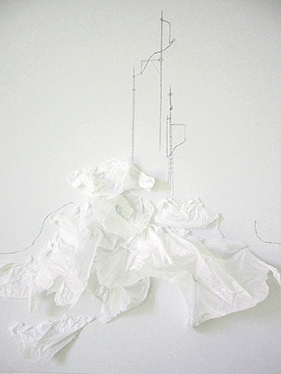 |
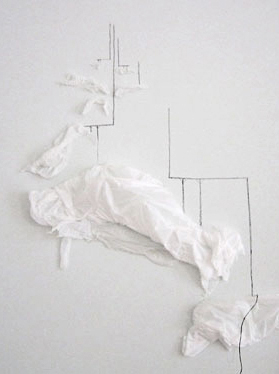 |
| The Quietening I (detail) | The Quietening VI (detail) |